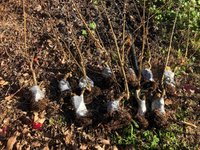Shibui
Imperial Masterpiece
It is almost middle of winter down here so I've started opening the new root over rock plantings to see what I've got this time.
Some of you are aware that I've developed foil wrap as a means of getting reliable ROR.
Young seedlings with flexible roots are positioned on the rock then the roots are wrapped in alfoil. Advantages are: it can be moulded to the shape of uneven rocks; Roots do not usually grow through the foil; Soil outside provides some pressure to hold the roots close to the rock; Provides consistently moist conditions so roots will grow in the space between rock and foil.
After the initial wrap the ROR starters are planted together in boxes and kept in the nursery for the first summer to allow roots to strengthen and grow out the bottom of the wrap.

The following season I plant them in the ground to speed up growth and thickening
If you could guarantee good watering you could probably go straight to the ground but watering is a bit erratic here so they do better under the watering system for the first season.
For the last 3 years I've been trying to develop good shohin sized ROR. They'll grow way too much in the grow beds and swamp the rocks so these will be grown on in pots to restrict the growth a bit.
Here are a few of this year's crop.






Even with some experience things still don't always work as expected. Note the root in the second pic that was folded and now grows back under another root. That would have been much better if it went around behind the rock. Experience shows that the one going under will start to lift the other root away from the rock and may even push the rock out of the roots as there's no good roots on the right side now.
Some of you are aware that I've developed foil wrap as a means of getting reliable ROR.
Young seedlings with flexible roots are positioned on the rock then the roots are wrapped in alfoil. Advantages are: it can be moulded to the shape of uneven rocks; Roots do not usually grow through the foil; Soil outside provides some pressure to hold the roots close to the rock; Provides consistently moist conditions so roots will grow in the space between rock and foil.
After the initial wrap the ROR starters are planted together in boxes and kept in the nursery for the first summer to allow roots to strengthen and grow out the bottom of the wrap.

The following season I plant them in the ground to speed up growth and thickening
If you could guarantee good watering you could probably go straight to the ground but watering is a bit erratic here so they do better under the watering system for the first season.
For the last 3 years I've been trying to develop good shohin sized ROR. They'll grow way too much in the grow beds and swamp the rocks so these will be grown on in pots to restrict the growth a bit.
Here are a few of this year's crop.






Even with some experience things still don't always work as expected. Note the root in the second pic that was folded and now grows back under another root. That would have been much better if it went around behind the rock. Experience shows that the one going under will start to lift the other root away from the rock and may even push the rock out of the roots as there's no good roots on the right side now.































